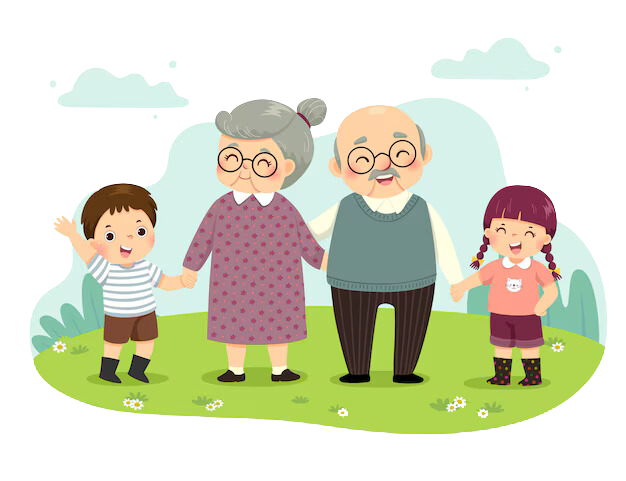Using Technology to Bridge the Generational Gap
- jessicaaqian
- Oct 11, 2024
- 4 min read
Updated: Apr 17
Ever heard complaints about people’s elderly grandparents being so old-fashioned? Or maybe some of us who are younger might be more familiar with being called “strawberry generation”, or being told that youth of today are ignorant and unreliable. Whether we realise this or not—traces of the generational gap can be found in so many aspects of our lives!
What Is The “Generational Gap”?
The generation gap is a phenomena whereby people of different generations are distant and at times even discriminatory towards one another (Thang, 2011). This is most commonly associated with the gap between grandparents and grandchildren or even parents and their children, though it could include friendships and relationships outside the family as well.

Why should we care about this?
Not only does the generational gap lead to weakened family ties, it also poses a threat to social cohesion and builds tensions between generations (Thang, 2011).
Research has found that this divide between generations paves the way for ageism (Hagestad & Uhlenberg, 2005), which can be understood as “stereotypes, prejudice, or discrimination against (but also in favor of) people because of their chronological age” (Ayalon & Tesch-Römer, 2017). This could apply to both young or old.
Ageism can have detrimental consequences for victims, and studies have shown a link with increased mental health concerns, such as anxiety, depression and lower quality of life (Ribeiro-Gonçalves et al., 2023).
Moreover, with prolonged exposure to these stigmatizing attitudes, stereotype embodiment theory could occur, whereby (Kang & Kim, 2022):
Individuals resign themselves to the stereotyped portrayal of themselves, for instance, becoming less healthy as a result
Individuals may be less willing to take on growth opportunities
Their self-esteem could be further compromised
How can We Use Technology To Bridge The Generational Gap?
Some might believe that technology contributes to a greater divide between generations. Indeed, the way it is used is very much stratified and divided by age group (Lapa & Cardoso, 2013). Could it be, however, that these advances actually provide us with more avenues to bring generations together? With technology at our fingertips, each of us can be a positive force for change in our own little ways. Research has found that multiplayer video games help to increase social interaction and communication between players of different generations. Interestingly, the mode of gameplay makes a difference (Zahn et al., 2022):
Creative mode increases verbal communication, providing more opportunities to converse due to how much freedom is given to players
Competitive mode increases non-verbal communication such as laughing (when players are non-threatening), which helps to lighten the mood
Cooperative mode increases help-seeking communication
Reverse mentoring is a technique used in workplaces where younger employees serve as mentors to their older colleagues and has been largely seen as successful (Frey, 2021). Youths are able to develop greater patience and understanding towards elderly when teaching them to use technology, while the elderly would gain greater confidence in utilizing technology—so it can be a win-win! (Flynn, 2022). This means that…
For those of us who are younger, we would benefit from teaching older family members, friends or colleagues how to use digital media
Not only does this help them improve their digital literacy, it can help you bond with them
For those of us who are older, there is no shame in learning from younger people!
Ultimately, researchers believe that the best way to overcome prejudice is “sustained familiarity”, which can be built through “stable, lasting interactions” with people of different age groups (Hagestad & Uhlenberg, 2005). Thankfully, technology provides many opportunities for that! Some options we can consider would be…
Making TikToks together as a family
Using online tutorials to learn new recipes or arts and craft
Using digital media to keep in touch virtually
References
Ayalon, L., & Tesch-Römer, C. (2017). Taking a closer look at ageism: Self- and other-directed ageist attitudes and discrimination. European Journal of Ageing, 14(1), 1–4. https://doi.org/10.1007/s10433-016-0409-9
Flynn, S. (2022). Bridging the age-based digital divide: An intergenerational exchange during the first covid-19 pandemic lockdown period in ireland. Journal of Intergenerational Relationships, 20(2), 135–149. https://doi.org/10.1080/15350770.2022.2050334
Frey, T. K. (2021). Overcoming technological barriers to instruction: Situating gen z students as reverse mentors. Frontiers in Communication, 6. https://www.frontiersin.org/articles/10.3389/fcomm.2021.630899
Hagestad, G. O., & Uhlenberg, P. (2005). The social separation of old and young: A root of ageism. Journal of Social Issues, 61(2), 343–360. https://doi.org/10.1111/j.1540-4560.2005.00409.x
Kang, H., & Kim, H. (2022). Ageism and psychological well-being among older adults: A systematic review. Gerontology and Geriatric Medicine, 8, 233372142210870. https://doi.org/10.1177/23337214221087023
Lapa, T., & Cardoso, G. (2013). What “digital divide” between generations? A cross-national analysis using data from the world internet project. In C. Stephanidis & M. Antona (Eds.), Universal Access in Human-Computer Interaction. User and Context Diversity (pp. 113–122). Springer. https://doi.org/10.1007/978-3-642-39191-0_13
Ribeiro-Gonçalves, J. A., Costa, P. A., & Leal, I. (2023). Loneliness, ageism, and mental health: The buffering role of resilience in seniors. International Journal of Clinical and Health Psychology, 23(1), 100339. https://doi.org/10.1016/j.ijchp.2022.100339
Thang, L. L. (2011). Promoting intergenerational understanding between the young and old: The case of Singapore . United Nations Department of Economic and Social Affairs Social Inclusion. https://www.un.org/esa/socdev/family/docs/egm11/EGM_Expert_Paper_Theng_Leng_Leng.pdf
Zahn, C., Leisner, D., Niederhauser, M., Roos, A.-L., Iseli, T., & Soldati, M. (2022). Effects of game mode in multiplayer video games on intergenerational social interaction: Randomized field study. JMIR Formative Research, 6(2), e29179. https://doi.org/10.2196/29179








Comments